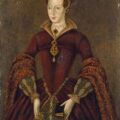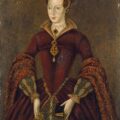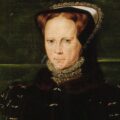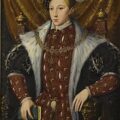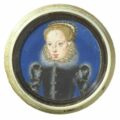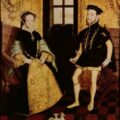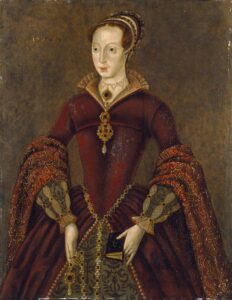
I’ve written a two part post about the executions of Lady Jane Grey and her husband, Guildford Dudley, over at the Anne Boleyn Files – see “The Execution of Lady Jane Grey – Part One”, but I thought it would be good to do a Lady Jane Grey bio or factfile here:-
Lady Jane Grey Facts
- Birth: Traditionally thought to be the same month as Edward VI, October 1537, but Eric Ives puts her birth at around April/May 1537 due to a letter written by her tutor, John Aylmer, (written in around May 1551) saying that she had just turned 14. Leanda de Lisle also chooses May 1537 for Jane’s birth.
- Birthplace: Bradgate Park, Leicestershire.
- Father: Henry Grey, 1st Duke of Suffolk, who was descended from Elizabeth Woodville and her first husband Sir John Grey
- Mother: Lady Frances Brandon, the daughter of Charles Brandon and Mary Tudor (Henry VIII’s sister).
- Brothers and sisters: Katherine Grey (1540) who married Henry, Lord Herbert, and then Edward Seymour, Earl of Hertford, and Mary Grey (1545) who married Thomas Keyes.
- Appearance: A Genoese merchant described Jane as “very short and thin, but prettily shaped and graceful. She has small features and a well-made nose, the mouth flexible and the lips red. The eyebrows are arched and darker than her hair, which is nearly red. Her eyes are sparkling and reddish brown in colour. I stood so near her grace that I noticed her colour was good but freckled. When she smiled she showed her teeth which are white and sharp. In all a gracious and animated figure.”* (Quoted in Eric Ives’s “Lady Jane Grey: A Tudor Mystery”)
- Education: Jane was an intelligent girl and received a top-class education. Her main tutor was John Aylmer but she also met the top scholars of the day during her time living with Catherine Parr and Thomas Seymour, as well as famous reformists and humanists. Alison Weir describes Lady Jane Grey as one of “the finest female minds of the century”. She loved Greek and was a linguist with a knowledge of Latin and Hebrew on top of the usual modern languages.
- Marriage: May 1553 to Guildford Dudley, son of John Dudley, the Duke of Northumberland and Edward VI’s chief adviser. It was a triple marriage – Jane’s sister married Lord Herbert and Guildford’s sister, Catherine, married Lord Hastings.
- The Succession Question: Before his death in July 1553, Edward VI wrote his “Deuise for the Succession”, his Device for the Succession. In the final version, Edward excluded his sisters, Mary and Elizabeth from the succession and named Lady Jane Grey as his heir.
- Reign: Edward VI died on the 6th July 1553 and on the 7th July the Mayor of London and other city officials were called to Greenwich to swear an oath of allegiance to Queen Jane. Although Jane is often referred to as “The Nine Day Queen” she actually reigned for 13 days – 6th July to the 19th July when Mary I was proclaimed Queen.
- Trial: 13th November 1553 – Guildford and Jane were both found guilty of high treason. Both were sentenced to death, Jane by being burned alive or beheaded “as the Queen pleases”. It was however thought that Mary would spare her life and viewed her as an innocent.
- Jane’s Downfall: The nail in Jane’s coffin was Wyatt’s Rebellion of January 1554. Although Jane was not involved in any way, her father, the Duke of Suffolk, was involved and Jane was used as a figurehead. Mary was then pressurised by her husband, Philip of Spain, to get rid of Jane who could be used again as a focus of rebellion.
- Death: 12th February 1554. Beheaded on Tower Green at the Tower of London. Jane’s husband, Guildford Dudley was executed on the same day but earlier on Tower Hill.
- Resting Place: The Chapel of St Peter ad Vincula, the Tower of London.
- Views of Lady Jane Grey: The Victorians saw Lady Jane Grey as an innocent or as a romantic heroine, and Paul Delaroches’s painting “The Execution of Lady Jane Grey”, depicting a poignant scene where a girl dressed in white is being helped to find the block, added credence to this view. The Victorians also saw Jane as a model for Victorian women. She has also been seen as a martyr of the Protestant faith and Eric Ives likens her to Anne Frank as both were victims of brutality. While some see Jane as a girl who was manipulated and forced into being Queen, Leanda de Lisle paints her as quite a strong character who saw it as her God-given duty to become Queen and who took steps to raise support against Mary’s challenge.
You can read more details on Lady Jane Grey’s execution, including her execution speech, in my two part series at the Anne Boleyn Files – see “The Execution of Lady Jane Grey – Part One”.
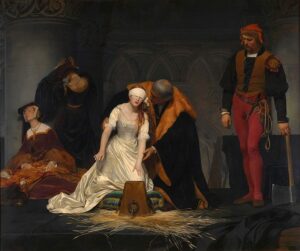
Lady Jane Grey’s Execution and Elizabeth
What was so chilling about this execution in Elizabeth’s eyes was that it showed that Mary could and would execute family, someone with Tudor blood, and that she would take harsh action against those implicated in rebellions – scary for Elizabeth when she herself was a figurehead for that same rebellion, Wyatt’s Rebellion – would Mary execute her? This thought obviously crossed Elizabeth’s mind because, as Linda Porter writes:
“The axe had fallen on Lady Jane and now its shadow now hung over Elizabeth herself.”
Elizabeth had every reason to believe that her sister was capable of passing the death sentence on her too.
Fortunately, there was no evidence to prove that Elizabeth was involved and even under torture Wyatt did not link Elizabeth’s name to his rebellion – phew! But Lady Jane Grey was not so lucky and the teenage girl lost her life shortly after Wyatt’s Rebellion.
RIP Lady Jane Grey and Guildford Dudley, may you never be forgotten.
*As Leanda de Lisle has pointed out below, in the comments, she discusses this description of Jane in her book “The Sisters Who Would Be Queen” (US version and the soon to be released UK paperback). In it, she says that the description was invented by Richard Davey, a journalist and author, and that it did not exist before 1909.
